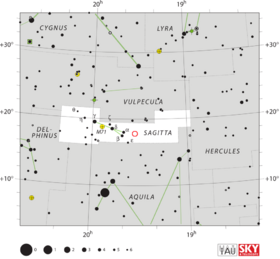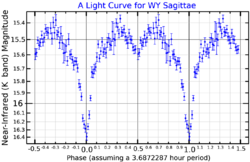Astronomy:WY Sagittae
| Observation data Equinox J2000.0]] (ICRS) | |
|---|---|
| Constellation | Sagitta |
| Right ascension | 19h 32m 43.819s[1] |
| Declination | 17° 44′ 55.86″[1] |
| Apparent magnitude (V) | 5.4 - 20.7 (Blue)[2] |
| Astrometry | |
| Distance | 4200+400 −400[3] pc |
| Characteristics | |
| Variable type | Nova, Eclipsing binary |
| Other designations | |
| Database references | |
| SIMBAD | data |
WY Sagittae, also known as Nova Sagittae 1783, is a star in the constellation Sagitta which had a nova eruption visible in 1783. It was discovered on 26 July 1783 by the French astronomer Joseph Lepaute D'Agelet. It is usually difficult to precisely identify novae that were discovered hundreds of years ago, because the positions were often vaguely reported (for example the discoverer may have only reported the constellation where the nova occurred) and historically there was not a clear distinction drawn between different sorts of transient astronomical events such as novae and comet apparitions.[5] However D'Agelet observed this nova with a mural quadrant, which produced coordinates accurate enough to allow modern astronomers to identify the star.[6] D'Agelet reported the apparent magnitude of the star as 6, but Benjamin Apthorp Gould, who analysed D'Agelet's records, determined that what D'Agelet called magnitude 6 corresponds to magnitude 5.4 ± 0.4 on the modern magnitude scale,[7] so the nova was visible to the naked eye.
Very little is known about WY Sagittae's post-eruption light curve. D'Agelet reported the star's magnitude as 6, 6 and 6.7 on the 26th, 27th and 29 July 1783, respectively. At least a half dozen observers attempted to find D'Agelet's nova in the late 19th and early 20th centuries, without success.[6] In 1942 a photographic search for the nova was performed using the 60-inch telescope on Mt. Wilson, and in 1950 Harold Weaver tentatively identified a faint blue star with a photographic magnitude of 18.9 as the quiescent nova. The star was only a few arc seconds away from D'Agelet's reported position, and fluctuations in its brightness added to the confidence that it was indeed the nova.[6] In 1971 Brian Warner observed Weaver's candidate for WY Sagittae with the Otto Struve Telescope, and saw rapid brightness variations that are ubiquitous in quiescent novae, which confirmed Weaver's identification of D'Agelet's nova.[9]
All novae are binary stars, with a "donor" star orbiting a white dwarf. The two stars are so close together that matter is transferred from the donor star to the white dwarf. Because the distance between the stars is comparable to the radius of the donor star, novae are often eclipsing binaries, and WY Sagittae does show eclipses. The eclipses, which are quite deep (two magnitudes), show that the binary's orbital period is 3 hours and 41 minutes.[10][11] Christian Knigge classified the donor star's spectral type as M4±1.[12] Somers et al. estimate the donor star's spectral type to be between M3.5 and M4.5, and the mass of the white dwarf to lie between 0.5 M☉ and 1.1 M☉.[13]
Özdönmez et al. estimate WY Sagittae's distance to be 4200±400 parsecs, based on reddening.[3]
WY Sagittae is sometimes listed as the second oldest "recovered" nova (meaning a historical nova for which modern observations have unambiguously identified the post-nova star), with only CK Vulpeculae being older.[14] But Naylor et al. argue that CK Vulpeculae is not a nova, and WY Sagittae is the oldest recovered nova.[15]
References
- ↑ 1.0 1.1 Webbink, R.F.; Hazen, M.L.; Hoffleit, D. (July 2002). "Coordinates and Identifications of Harvard Variables". Information Bulletin on Variable Stars 5298: 1. Bibcode: 2002IBVS.5298....1W.
- ↑ Downes, Ronald; Webbink, Ronald F.; Shara, Michael M. (April 1997). "A Catalog and Atlas of Cataclysmic Variables-Second Edition". Publications of the Astronomical Society of the Pacific 109: 345–440. doi:10.1086/133900. Bibcode: 1997PASP..109..345D.
- ↑ 3.0 3.1 Özdönmez, Aykut; Güver, Tolga; Cabrera-Lavers, Antonio; Ak, Tansel (September 2016). "The distances of the Galactic novae". Monthly Notices of the Royal Astronomical Society 461 (2): 1177–1201. doi:10.1093/mnras/stw1362. Bibcode: 2016MNRAS.461.1177O.
- ↑ "WY Sge". SIMBAD. Centre de données astronomiques de Strasbourg. http://simbad.u-strasbg.fr/simbad/sim-basic?Ident=WY+Sge.
- ↑ Hoffmann, Susanne M.; Vogt, Nikolaus (July 2020). "Counterparts of Far Eastern Guest Stars: Novae, supernovae, or something else?". Monthly Notices of the Royal Astronomical Society 496 (4): 4488–4506. doi:10.1093/mnras/staa1685. Bibcode: 2020MNRAS.496.4488H.
- ↑ 6.0 6.1 6.2 Weaver, Harold F. (March 1951). "The Identification of D'agelet's Nova Sagittae of 1783". The Astrophysical Journal 113: 320. doi:10.1086/145402. Bibcode: 1951ApJ...113..320W.
- ↑ Augustus Addison Gould; Benjamin Apthorp Gould; Benjamin Peirce; Hubert Anson Newton; William Holms Chambers Bartlett (1866). Reduction of the Observations of Fixed Stars Made by Joseph D'Agelet, at Paris, in 1783-1785: With a Catalogue of the Corresponding Mean Places, Referred to the Equinox of 1800.0. U.S. Government Printing Office. p. 237. https://books.google.com/books?id=dIg4AQAAMAAJ.
- ↑ Somers, M. W.; Mukai, K.; Naylor, T. (February 1996). "Infrared photometry of WY Sge: just an ordinary old nova?". Monthly Notices of the Royal Astronomical Society 278 (3): 845–853. doi:10.1093/mnras/278.3.845.
- ↑ Warner, Brian (December 1971). "Photometry of WY SGE (Nova Sagittae 1783)". Publications of the Astronomical Society of the Pacific 83 (496): 817. doi:10.1086/129222. Bibcode: 1971PASP...83..817W.
- ↑ Shara, M.M.; Moffat, A.F.J. (January 1983). "WY Sagittae (Nova 1783) : spectroscopic confirmations of Weaver's candidate and discovery of deep eclipses". The Astrophysical Journal 264: 560–562. doi:10.1086/160624. Bibcode: 1983ApJ...264..560S.
- ↑ Shara, M.M.; Moffat, A.F.J.; McGraw, J.T.; Dearborn, D.S.; Bond, H.E.; Kemper, E.; Lamontagne, R. (July 1984). "WY Sagittae (nova 1783) : a transition object between classical and dwarf novae ?". The Astrophysical Journal 282: 763–768. doi:10.1086/162260. Bibcode: 1984ApJ...282..763S.
- ↑ Knigge, Christian (December 2006). "The donor stars of cataclysmic variables". Monthly Notices of the Royal Astronomical Society 373 (2): 484–502. doi:10.1111/j.1365-2966.2006.11096.x. Bibcode: 2006MNRAS.373..484K.
- ↑ Somers, M.W.; Ringwald, F.A.; Naylor, T. (January 1997). "Spectroscopy of WY Sagittae (Nova 1783): detection of the irradiated secondary star". Monthly Notices of the Royal Astronomical Society 284 (2): 359–364. doi:10.1093/mnras/284.2.359. Bibcode: 1997MNRAS.284..359S.
- ↑ Shara, Michael M. (January 1989). "Recent Progress in Understanding the Eruptions of Classical Novae". Publications of the Astronomical Society of the Pacific 101: 5. doi:10.1086/132400. Bibcode: 1989PASP..101....5S.
- ↑ Naylor, T.; Charles, P.A.; Mukai, K.; Evans, A. (October 1992). "An observational case against nova hibernation". Monthly Notices of the Royal Astronomical Society 258 (3): 449–456. doi:10.1093/mnras/258.3.449. Bibcode: 1992MNRAS.258..449N.
 |



